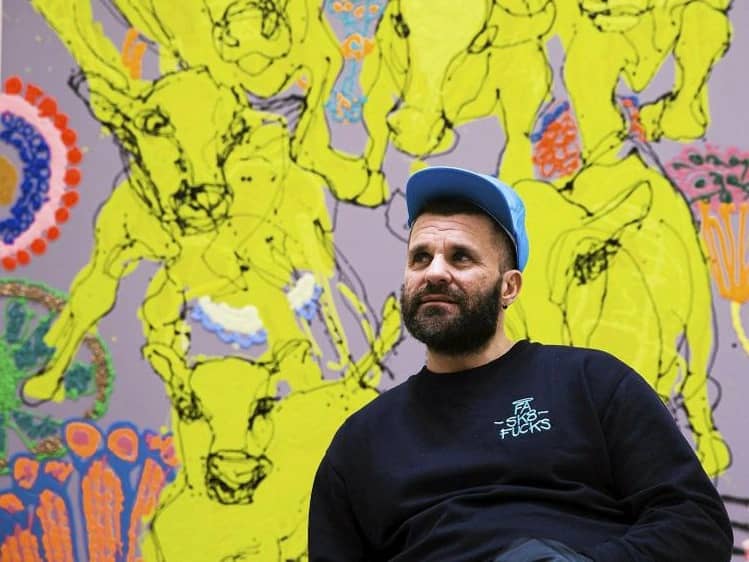위키 구독하기
Share wiki
Bookmark
Bjarne Melgaard
Bjarne Melgaard
비아르네 멜가르드(Bjarne Melgaard)는 1967년 9월 9일 출생한 뉴욕시를 기반으로 활동하는 현대 노르웨이 예술가입니다. 그는 감각적인 설치 작품을 통해 재료를 조합하여 만든 물질적 예술, 논란의 여지가 있는 가구, 표현주의 회화 및 레터 아트로 유명합니다.[1] 비아르네는 어린 시절부터 소설을 써왔습니다. 그는 자신의 생각을 표현하고 자신을 표현하는 형태로 소설에 매료되었습니다. 그는 소설 또한 책이라는 형태로 우리를 둘러싸고 있는 '예술 작품'이라고 말합니다.
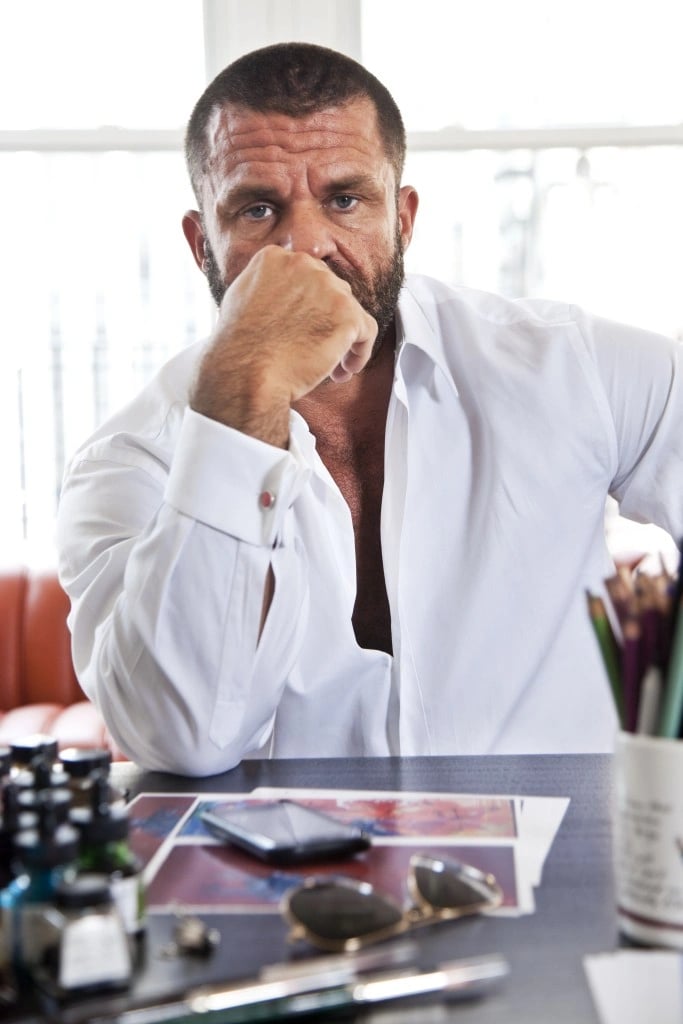
저는 패션과 글쓰기에 관심이 있었습니다. 14편의 소설을 출판했죠—어릴 적부터 글을 써왔습니다. 그래서 제가 하는 모든 것과 연결되어 있습니다. 저는 제 그림도 소설로, 제 전시도 소설로 봅니다. 아마 제가 그것을 하나로 보는 것 같습니다. 제 글은 항상 제 그림과 설치 작품에 있었고, 항상 그 일부였습니다.
뉴욕 레드불 아트에서의 인터뷰에서 비아르네 멜가르드가 한 말입니다.[14]
초기 생애 및 교육
1967년생인 비아르네 멜가르드(Bjarne Melgaard)는 호주 시드니에서 노르웨이 출신 부모 사이에서 태어나 노르웨이 오슬로에서 자랐습니다. 그는 1991년 노르웨이 오슬로 국립미술학교(National Academy of Fine Arts, Oslo)를 졸업했습니다. 이후 네덜란드 암스테르담의 라이크스아카데미(Rijksacademie)에서 수학하여 1992년 졸업했습니다. 1993년에는 네덜란드 마스트리흐트의 얀 반 에이크 아카데미(Jan van Eyck Academie)를 졸업했습니다.[4]
예술 경력
멜가르드(Melgaard)의 작품 세계는 사회적, 정치적, 이념적 문제를 중심으로 합니다. 그의 작품은 자기 파괴, 일탈적인 성, 기이한 종교적 신념 등 인간의 어두운 면을 다루며 사회적 수용의 경계를 탐구하고 있습니다[3]. 시각 예술 외에도 멜가르드는 다작하는 큐레이터, 작가, 영화 제작자, 패션 디자이너이기도 합니다. 그의 작품은 헤비메탈 음악, 마약 중독, 증강 및 가상 현실을 포함한 자극적인 하위 문화를 탐구해왔습니다.
멜가르드의 작품은 두꺼운 유화 물감, 인조 모발, 눈에 거슬리는 색상의 화장품으로 표현된 동물과 인간을 담고 있으며, 단색 배경을 사용하는 경우가 많습니다.
멜가르드는 런던 ICA(Institute of Contemporary Arts)(2012)와 오슬로 아스트룹 퍼른리 미술관(Astrup Fearnley Museum of Modern Art)(2010)에서 개인전을 여는 등 국제적으로 광범위하게 전시회를 개최했습니다. 베니스 비엔날레(2011), 리옹 비엔날레(2013), 휘트니 비엔날레(2014)에도 참여했습니다.
- 1996년 벨기에 겐트 현대미술관(Museum van hedendaagse Kunst, Ghent)에서 첫 개인전인 "회복 중인 미니멀리스트의 고백(Confessions of a Recovering Minimalist)"을 개최했습니다. 윌리엄 비일(Guillaume Bijl), 갤러리 c/o 알테 게르하르센(Galleri c/o Alte Gerhardsen), 오슬로, 노르웨이[5].
- 2000년 뉴욕에서 첫 패션 개인전을 열었는데, 아기 옷을 입은 살아있는 치와와와 노골적인 성행위를 하는 유인원 조각상을 선보였습니다. 그의 가장 악명 높은 작품들은 동시에 가장 논란이 많은 작품들입니다.
- 2013년 뉴욕 게빈 브라운 엔터프라이즈(Gavin Brown’s enterprise)에서 열린 "무지한 투명성(Ignorant Transparencies)" 전시회에는 환각적인 색상의 페인트로 뒤덮인 거대한 크랙을 피우는 핑크 팬더가 포함되었는데, 이는 멜가르드의 또 다른 자아로 여겨집니다.
제 작품 일부에 묘사된 소위 파괴적인 문화는 일반 문화의 일부라고 생각합니다. 단지 보이지 않을 뿐입니다. 매체를 통해 사람들이 매일 접하는 것들이 예술 작품으로 표현될 때 훨씬 더 자극적으로 다가옵니다.
멜가르드의 말입니다[9].
- 멜가르드는 특히 알드리치(Aldrich)의 작품을 높이 평가하며 다음과 같이 말했습니다.
알드리치의 작품은 이해하기 너무 어렵고 전혀 이해할 수 없습니다. 또한 전혀 비선형적입니다. 그가 하는 일이 흥미로운데, 제가 하는 일과는 너무나 다르기 때문입니다.
실제로 알드리치의 광활한 흰색 작품들은 멜가르드의 생생한 초상화와 시각적으로 완전히 대조되는 것처럼 보입니다. 멜가르드는 그 초상화의 주제에 대해 함구하고 있는데, "허구의 인물과 실존 인물의 혼합"이라고 알려져 있습니다[12].
논란
인종차별 의자 (Racist Chair)
2014년 1월, 비아르네 멜가르드(Bjarne Melgaard)의 작품 *의자(Chair)*가 논란을 불러일으켰습니다. 도발적인 성적 자세로 조각된 의자는 영국의 팝 아티스트 앨런 존스(Allen Jones)의 유사한 작품을 재해석한 것입니다. 예술에서의 불쾌감은 종종 불의를 풍자하는 방법이지만, 이 도발적인 조각은 유명인을 겨냥하여 인종차별적인 이름을 부르는 대중문화에 순진하게 주입되었습니다.[16]
논란은 러시아의 아트 소셜라이트 다샤 주코바(Dasha Zhukova)가 패션 웹사이트를 위해 의자 쿠션에 앉은 사진이 공개되면서 격렬한 온라인 인종차별 비난으로 이어지면서 시작되었습니다.
주코바는 이러한 격렬한 논란에 대해 다음과 같이 답했습니다.
완전히 맥락에서 벗어나 공개된 이 사진은 성과 인종 정치에 대한 논평으로 특별히 의도된 예술 작품입니다. 저는 인종차별을 혐오하며, 이 이미지로 인해 불쾌감을 느낀 모든 분들께 사과드립니다.
멜가르드 자신도 논란에 대해 성명을 발표했는데, 일부 작가들은 이를 "기이한" 것으로 묘사했습니다.
Death House
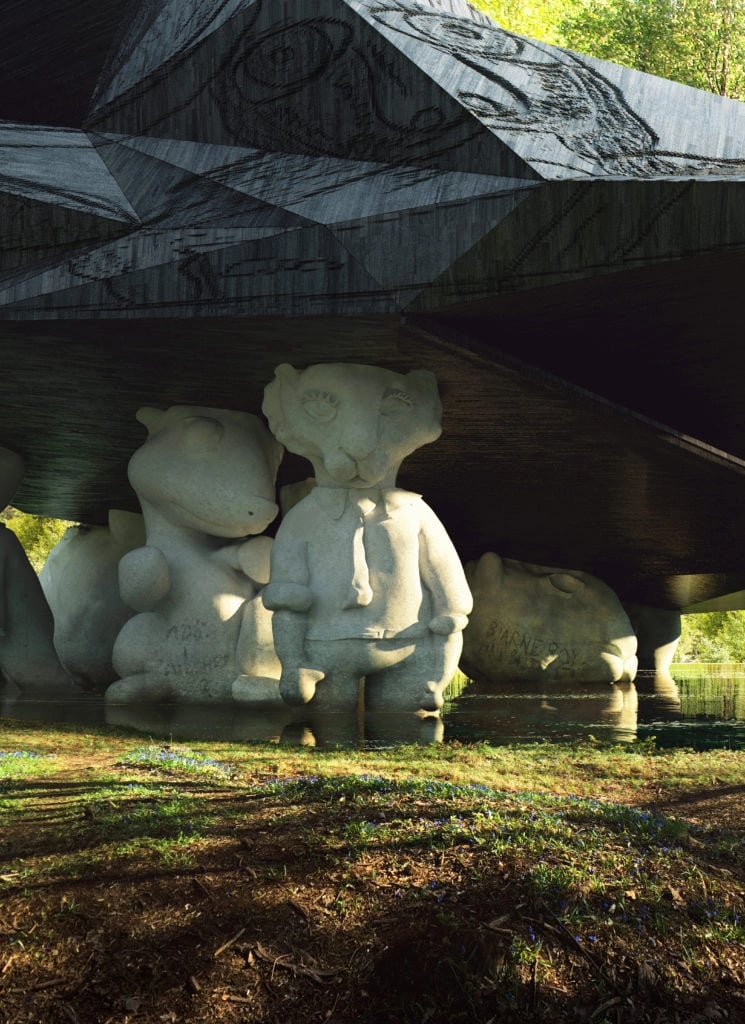
Melgaard’s planned building is shaped like a UFO. The building is clad with black, burned oak, inspired by Japanese building traditions. The burnt oak naturally erodes over time so that the building gradually changes character throughout the years and seasons. Bjarne’s drawings are projected back onto the geometrical facades.
Nothing has been built on the plot since the villa that used to adorn the plot was demolished in 1989, and the Selvaag brothers see a good opportunity to realize an ambitious art project on behalf of Bjarne Melgaard and to co-create a house that could function as his private residence and atelier.[11]
To build a spacey home beside the site of Edvard Munch’s former home has hit another setback in Oslo. On August 20, the city council blocked the project, referring to it a “death house” in their statement. Munch’s descendants claimed Melgaard was degrading Munch.
The Norwegian politicians opposed the construction of building by saying,
We want the site where the death house was intended to be placed to remain a green area for the benefit of the local population, and we encourage Bjarne to find a new site for the project.
짐 퀸즈 디저브 투 다이 (Gym Queens Deserve To Die)
2015년, 오슬로(Oslo) 뭉크 미술관(Munch Museum)에서 열린 비아르네(Bjarne)의 전시회에서 아동 성적 학대 혐의로 경찰이 출동했으나, 무혐의 처분을 받았습니다. 방문객들이 그의 비디오 *짐 퀸즈 디저브 투 다이(Gym Queens Deserve to Die)*에 대해 항의했는데, 이 비디오에는 모델이 아기의 팔을 입에 넣는 성적 행위가 담겨 있었습니다. 그는 소아성애 혐의를 받았지만, 노르웨이 경찰은 범죄 행위를 발견하지 못했습니다. 뭉크 미술관은 전시회를 강력히 옹호했으며, 일각에서는 뭉크 자신도 그의 시대에 선동가였다는 점을 지적했습니다.[15]
시각적 자료
2012년, AIDS Roulette라는 퍼포먼스 작품에서 여섯 명의 남성이 성행위를 하는데, 그중 한 명이 AIDS 양성 반응을 보입니다.
Elizabeth And Me
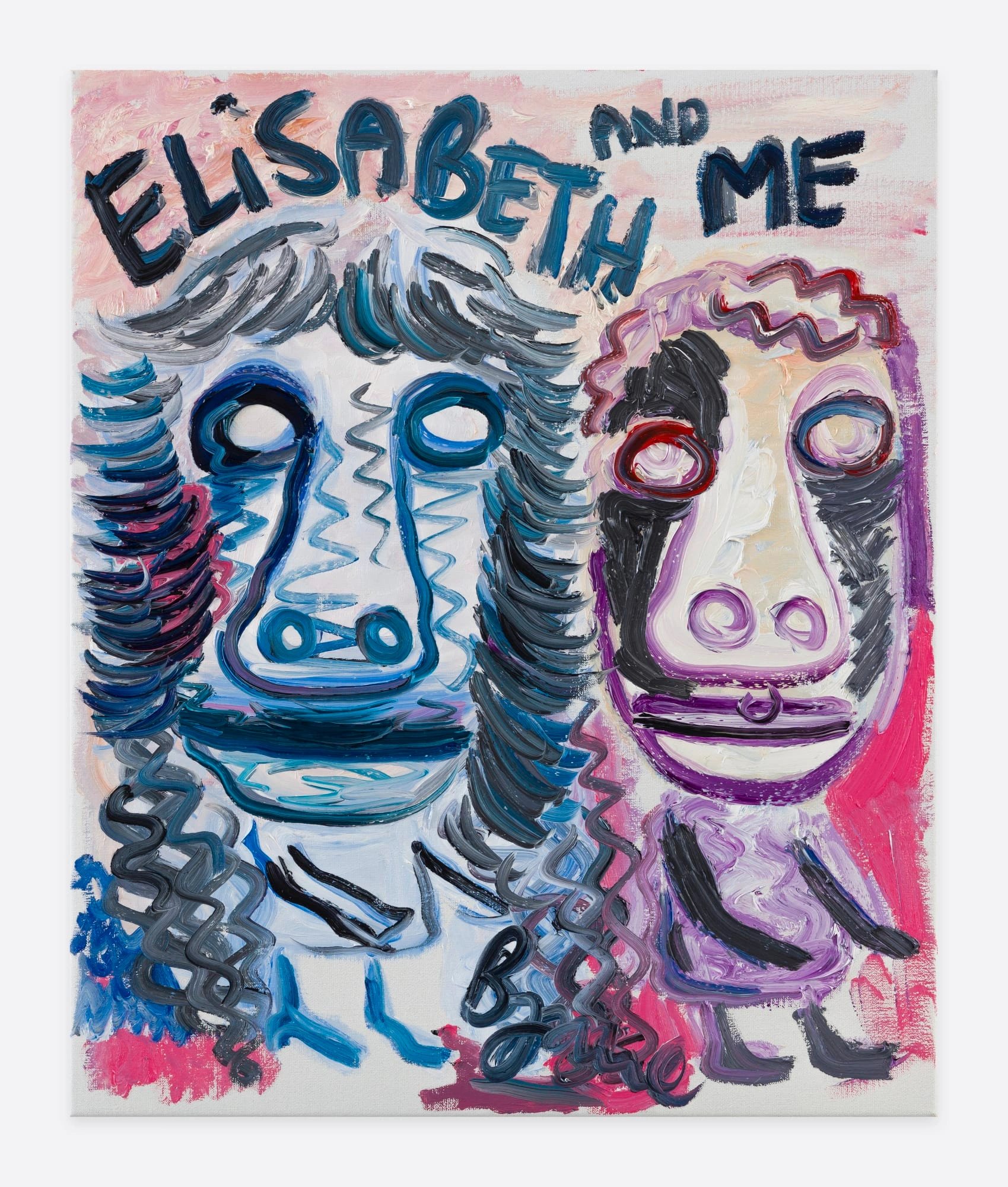
Bjarne는 Elizabeth Wurtzel을 직접 만난 적이 없지만 그녀의 불편함에 공감했습니다. 그는 자신과 Wurtzel 모두 노르딕 문화에 뿌리를 두고 있을 뿐만 아니라 같은 정신과 의사를 두고 있다는 것을 알게 되었습니다. Wurtzel의 도발적인 행동은 Bjarne의 그림에 반영되어 있으며, 그녀의 제스처를 밝은 색상과 두꺼운 임파스토 기법으로 응축시켜 말리고, 반항적이고 직관적인 것으로 표현합니다.[13]
실망의 쾌락 (Casual Pleasure of Disappointment)
2017년, 비아르네 멜가르드(Bjarne Melgaard)는 그의 지속적인 '패션' 프로젝트의 절정으로서, 여러 장소에서 여러 날에 걸쳐 진행되는 끈질긴 전시 *실망의 쾌락(The Casual Pleasure of Disappointment)*을 시작했습니다. 그는 2층짜리 레드불 갤러리를 '정신병리학적 백화점'으로 탈바꿈시켰는데, 교외 쇼핑센터를 연상시키는 낡은 설비들로 가득했습니다.

전시
1996년부터 2021년까지 비아르네 멜가르드(Bjarne Melgaard)는 220회가 넘는 개인전을 열었습니다.
- 그중 2000년 뉴욕 Alleged Gallery에서 열린 The Mutilation of the Apes 전시는 사람들 사이에 논쟁을 불러일으키며 그를 논란의 중심에 서게 한 작품입니다.
- 2008년 코펜하겐 Faurschou에서 열린 Edvard Munch: Tribute And Inspiration 전시는 비아르네 멜가르드를 비아르네의 정신적, 스타일적 멘토였던 에드바르트 뭉크(Edvard Munch) 이후 가장 유명한 노르웨이 예술가로 소개했습니다.
- 2012년 런던 현대미술연구소(ICA)에서 열린 Matt Williams가 큐레이팅한 Bjarne Melgaard: A house to die in 전시에서는 그의 '실험실'이 몇몇 작은 조각상을 기반으로 건설될 비전으로 소개되었으며, '죽음의 집(Death House)'으로도 언급되었습니다.
- 같은 해 뉴욕 La MaMa Galleria에서 열린 Visual AIDS 전시는 6명의 남성이 성행위를 하는 모습을 담았으며, 그중 한 명이 에이즈 양성 반응을 보였습니다.
- 2015년 노르웨이 오슬로 뭉크 미술관에서 열린 Munch and Melgaard: The end of it all has already happened 전시는 뭉크의 죽음을 기리는 전시로 유명했습니다.
공공 컬렉션 및 문헌
비야르네는 16개가 넘는 공공 컬렉션을 보유하고 있습니다. 이 중 오슬로 국립현대미술관(National Museum of Contemporary Art, Oslo)에 그의 작품이 가장 많이 소장되어 있습니다.
- 2002년, 'Bjarne Melgaard - Interface To God' 및 'Black Low // The Punk Movement Was Just Hippies With Short Hair'가 출판되었습니다.
- 2010년, 'Bjarne Melgaard: Jealous' 및 'Design: An Art Service'가 출판되었습니다.
라이트벌브 맨(Lightbulb Man, LBM)
모든 작품들은 그에 의해 ‘제목 없음’으로 발표되었습니다. 하지만, 라이트벌브 맨 작품을 구매하면 이름을 짓고 디지털 아트 역사에 새길 수 있습니다. 1025개의 독특한 작품들이 발표되었고, 동일하면서도 완전히 다릅니다. 멜가르드는 각 작품을 특별하고 숨겨진 특징들로 만들어, 모든 라이트벌브 맨을 서로 다르게 만들었습니다. 독특한 특징, 색상, 사물, 그리고 다른 마커들 - 모두 비아르네의 예술적 표현으로 구상되었습니다.
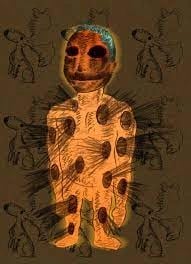
비아르네 멜가르드는 연쇄 기업가 샘 파라오와 파트너십을 맺고 1122개의 고유한 라이트벌브 맨 NFT 작품 컬렉션을 출시하여 악명 높은 인물을 이더리움 블록체인에 새롭게 선보였습니다. 그는 메타버스를 실험하여 그의 작품의 어두운 주제들을 탐구하는 허구의 세계인 스키게(Skygge)를 만들었습니다.
라이트벌브 맨과 그의 불안한 존재감은 형상 그 자체를 넘어서는 설명이 쉽지 않지만, 웹3 배포를 통한 어두운 표정과 선명한 색상으로의 조각상 재해석은 이 신화적인 작품에 대한 논의를 다시 시작하게 합니다. 물리적인 라이트벌브 맨은 노르웨이 국립 미술관에 있는 외로운 청동상입니다. [10]
AR 및 VR
증강현실
2020년, 비아르네 멜가르드(Bjarne Melgaard)의 AR 프로젝트는 그의 광범위한 작품에서 따온 등장인물과 모티프를 사용하는데, 중앙 아프리카 콩고민주공화국의 식민지화부터 빅테크의 국제적 영향력까지 현재와 역사적 사건들을 다양하게 반영합니다.[18]
가상현실
그의 가상현실 작품 My Trip(2019)은 관람자/사용자를 다크웹의 가장 깊숙한 곳으로 안내하는 여정을 제공합니다. 그는 몰입형 가상 풍경을 만들어 베를린에서 열린 가상현실 전시회에 참여했으며, 디지털 매체를 사용하여 자연 발생 약물인 디메틸트립타민(DMT, Dimethyltryptamine)[디메틸트립타민]의 경험을 재현했습니다. DMT는 가장 강력한 환각성 화학 물질로 간주되며 지구상의 거의 모든 생명체에서 발견됩니다.
25년 이상 작가의 작품에 반복적으로 등장하는 등장인물들(라이트벌브 맨과 옥토 포함)과 Acute Art와의 협업으로 탄생한 새로운 돌연변이와 인물들을 특징으로 하는 그의 작품 My Trip은 DMT 경험의 환상을 놀랍도록 자극적인 시각 자료로 보여줍니다.
자살을 실존적 질문으로, 새로운 사이키델리아로, 그리고 DMT 트립에서 자아 상실로 시작하여, 삶과 사람들이 어떻게 삶을 선택하는지에 대한 질문을 제기하며 멜가르드의 반출생주의(Anti-Natalism)와 인구 과잉에 대한 관점을 소개합니다.[20]
2002년 코펜하겐 Galleri Faurschou에서 전시된 Nothing Special에서 비아르네는 갤러리 공간을 작가의 존재/부재가 중요한 역할을 하는 총체적 설치 작품으로 변형시켰으며, 쌓여 있는 물체들이 살아 움직이는 듯한 공간을 연출했습니다. 잡식성 거대 생명체가 소비하고 배출한 제품들의 혼돈처럼 보이는 이 공간에서 관람객은 완전히 몰입하게 됩니다. 전시된 작품들 중에는 “당신은 나의 가라앉은 해변입니다”라는 노래 가사가 적힌 거대한 반투명 색상의 배너가 있었습니다. 이 배너와 멜가르드의 전 작품에서 반복되는 요소인 등장인물들이 등장하는 그림들과 함께 “화학 일기”라는 제목의 일련의 드로잉과 소규모 조각들이 있었습니다.[19]
투자자
- 이스라엘계 러시아 억만장자 로만 아브라모비치(Roman Abramovic)는 2013년 5월 스웨덴 스톡홀름에서 열린 부코프스키 경매에서 비아르네의 작품을 구매했습니다.
- 조세 무그라비(Jose Mugrabi)와 비토 슈나벨(Vito Schnabel)은 같은 경매에서 멜가르드의 작품을 구매했습니다. 다른 주목할 만한 투자자로는 프랑수아 피노(Francois Pinault)와 크리스텐 스베아스(Christen Sveaas)가 있습니다. [6]
잘못된 내용이 있나요?
